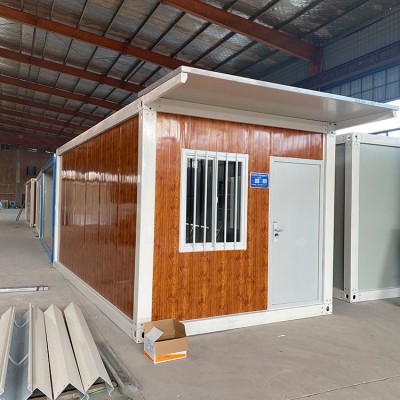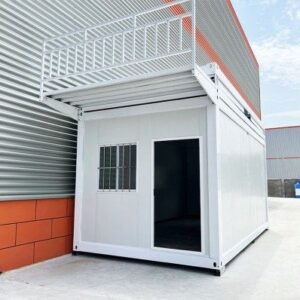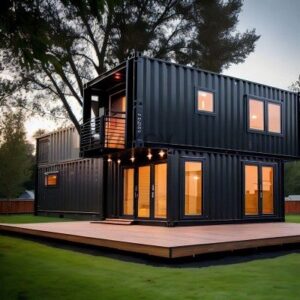If you’re wondering how to turn a shipping container into a house, you’re not alone. Shipping container homes are shaking up the housing market with their affordability, sustainability, and modern appeal. But transforming a steel box into a cozy, fully functional living space isn’t as simple as it sounds.
In this guide, you’ll get exactly what you need: clear, practical steps, expert tips on insulation, plumbing, permits, and design, plus a realistic look at costs and challenges. Ready to see how a shipping container can become your next dream home? Let’s get started!
Step-by-Step Process to Convert a Shipping Container into a House
Turning a shipping container into a house involves several key steps that cover everything from selecting the right container to final inspections. Here’s how the shipping container home conversion process typically unfolds:
Choosing and Purchasing Your Shipping Container
Start by deciding the type and size of container you need. Common options are 20-foot or 40-foot containers, with high cube versions offering extra height. Look for containers in good condition—avoid those with major rust or damage. You can buy new or used containers from local suppliers or specialized companies. Consider:
- One container for a tiny home or multiple containers for larger layouts
- Cleanliness and prior cargo—avoid containers that carried chemicals
Site Foundation and Preparation
A solid foundation is essential to support your container home safely. Options include:
- Concrete slab or piers – most common for uneven terrain
- Steel footings – lightweight and adjustable in some cases
- Gravel pads – acceptable for smaller or temporary builds
Make sure the site is level, accessible, and complies with local zoning regulations.
Cutting Openings for Doors Windows and Ventilation
Once the container is placed, cut openings for:
- Doors
- Windows
- Ventilation vents
This step requires precision to maintain the container’s structural integrity. Use professional tools or hire specialists if you’re uncertain.
Structural Reinforcements and Modifications
Containers are strong but not designed for large openings or additional floors without reinforcements. Add:
- Steel beams around doorways and windows
- Support frames for stacked containers or rooftop decks
Structural modifications ensure safety and compliance with building codes.
Insulation Techniques Suitable for Container Walls
Metal walls need good insulation to manage heat and cold. Common options:
- Spray foam insulation – excellent for sealing and moisture protection
- Rigid foam panels – easy to install and effective
- Blanket insulation like fiberglass is less common due to moisture concerns
Proper insulation also helps with energy efficiency and comfort.
Electrical and Plumbing Installations
Install wiring and plumbing to meet residential standards. Key points:
- Plan for outlets, lighting, and appliances early
- Use conduit to protect electrical lines on metal surfaces
- Plumbing requires careful placement to avoid leaks and freezing in colder climates
Hire licensed professionals to ensure safety and permit compliance.
Interior Finishing Flooring Walls and Ceiling
Once utilities are set, move to interior finishes:
- Flooring options include vinyl, laminate, or hardwood
- Walls can be framed with wood or metal studs and covered with drywall or paneling
- Ceilings can be insulated and finished similarly to walls
Choose materials that suit your style and climate.
Exterior Finishing and Weatherproofing
Protect your container from weather and rust with:
- High-quality exterior paint or metal coatings
- Sealant around seams and openings
- Optional cladding like wood siding or stucco for aesthetics and extra insulation
Good weatherproofing extends your home’s life and lowers maintenance costs.
Installing Fixtures and Fittings
Add the final touches:
- Kitchen and bathroom fixtures
- Lighting and switches
- Built-in furniture or storage units
This step personalizes your container home and makes it fully functional.
Final Inspection and Compliance Checks
Before moving in, ensure your container home passes all local building inspections. Verify:
- Structural integrity
- Electrical and plumbing compliance
- Fire safety measures
Getting final approvals keeps your home legal and safe.

Shipping Container Homes What They Are and Why They Matter
A shipping container home is a residential structure made by repurposing steel shipping containers into livable spaces. These containers, originally designed for transporting goods across oceans, offer a strong, modular, and cost-effective building material for innovative home construction. The process of shipping container home construction involves cutting, modifying, insulating, and finishing these containers to create comfortable, functional housing.
Types and Sizes of Shipping Containers for Homes
The most commonly used shipping containers for house building are:
- 20-foot containers (about 160 square feet) ideal for small homes or tiny house conversions.
- 40-foot containers (about 320 square feet) provide more livable space and are popular for full-sized homes.
- High-cube containers which add an extra foot of height for better interior clearance.
Many builders combine multiple containers side-by-side or stacked to create larger layouts and creative designs. The modular nature of containers allows for flexible shipping container house plans and designs, adapting to personal needs and site constraints.
Advantages of Shipping Container Homes
- Durability and Strength — Made of weather-resistant corten steel designed to withstand harsh environments.
- Speed of Construction — Faster build times compared to traditional homes due to prefabricated structure.
- Cost Efficiency — Often more affordable than conventional homes, especially with DIY builds.
- Mobility and Modularity — Containers can be transported easily, enabling modular expansions or relocations.
- Eco-Friendly Building Option — Repurposing containers reduces construction waste and promotes sustainable living.
Disadvantages of Container Homes
- Insulation Challenges — Metal containers conduct heat and cold, requiring careful insulation to ensure comfort.
- Space Limitations — Narrow width and height may feel cramped without clever layout design.
- Zoning and Permit Hurdles — Not all local jurisdictions fully approve of container homes, complicating legal compliance.
- Potential Structural Modifications — Cutting openings weakens the container’s natural integrity, needing reinforcements.
Environmental and Economic Benefits
Container homes are considered eco-friendly for several reasons:
- They reuse steel structures otherwise destined for scrap or landfill.
- Building with containers consumes fewer new building materials, cutting down resource extraction.
- The sturdy design leads to long-lasting homes with lower maintenance over time.
- They often require smaller foundations like concrete piers or slabs, minimizing site disturbance.
Economically, container homes offer:
- Lower material and labor costs in many cases.
- Less time on construction reduces financing and interest expenses.
- Potential for off-grid setups, reducing utility bills and promoting sustainable living.
By understanding the core features and trade-offs of shipping container home conversion, you can better assess if this innovative housing option fits your lifestyle, budget, and vision.
Planning and Preparation for Shipping Container Homes
Before starting your shipping container home conversion process, thorough planning is crucial. This phase sets a strong foundation for a smooth build that meets your needs and complies with local rules.
Assessing Feasibility Site Selection and Local Zoning Laws
Start by evaluating your land and site feasibility. Not all locations are suitable for container homes, especially when it comes to access, soil quality, and utility hookups. Check local zoning laws—some areas have restrictions on container homes or consider them temporary structures. Contact your local building office to confirm:
- If container homes are allowed in your area
- Minimum lot size requirements
- Setback and height restrictions
- Rules for foundations and utilities
Understanding these early prevents costly redesigns or permit issues later.
Budgeting How Much It Costs to Build a Container Home
The cost to build a container home varies widely, depending on size, design, location, and finishes. On average, building a basic container home can range from $150 to $250 per square foot. Key budgeting points include:
- Price of containers ($2,000 to $5,000 per container depending on condition)
- Site preparation and foundation work
- Modifications like cutting for windows and doors
- Insulation and HVAC installation
- Plumbing and electrical work
- Interior and exterior finishes
Make sure to include a buffer for unexpected expenses or changes.
Essential Permits and Legal Requirements
Securing the right permits for shipping container homes is not optional. Requires:
- Building permits for structural alterations
- Electrical and plumbing permits
- Inspections at various stages
- Possibly environmental assessments
These legal steps keep your project safe and legitimate, and help avoid fines or rollback orders.
Designing Your Home Layout for Space Comfort and Style
Design matters a lot with container homes since space is limited. Consider:
- Open floor plans to maximize space
- Multi-functional furniture for efficiency
- Natural light placements through windows and skylights
- Good ventilation for comfort
- Style choices that suit your preferences but fit container architecture
Work with an experienced designer or use shipping container house plans and designs available online as a starting point.
Focusing on these planning and preparation steps sets you up for success and ensures your container home fits your lifestyle and stays compliant with local standards.
Insulation and Climate Adaptation for Shipping Container Homes
Proper insulation is crucial when converting a shipping container into a livable home. Since metal containers conduct heat and cold very easily, without good insulation, your container house will be uncomfortable year-round—too hot in the summer and freezing in the winter.
Why Insulation Matters in Shipping Container Homes
- Metal walls transfer temperature quickly, causing heat loss or gain.
- Poor insulation leads to higher energy costs for heating and cooling.
- It helps prevent condensation inside the container, which can cause rust and mold.
- Insulation improves soundproofing, reducing outside noise.
Best Insulation Materials and Methods for Different Climates
Choosing the right insulation depends on where you live. Here are common options and their benefits:
| Insulation Type | Best For | Pros | Cons |
|---|---|---|---|
| Spray Foam | Cold and hot climates | Excellent sealing, high R-value, moisture barrier | Can be costly, professional install recommended |
| Rigid Foam Panels | Moderate climates | Durable, easy to install | Less effective at sealing air leaks |
| Fiberglass Batts | Dry climates | Affordable, widely available | Can absorb moisture leading to mold |
| Eco-friendly Options | Sustainable builds, any climate | Natural materials, non-toxic | Typically lower R-values, can be pricier |
Insulation should be installed inside the container walls, often paired with a vapor barrier to block moisture. It’s also important to insulate floors and roofs, which are exposed to extreme heat or cold.
HVAC Considerations in Container Homes
Since container homes have limited natural airflow, consider installing an efficient HVAC system to maintain comfort:
- Use mini-split heat pumps — energy-efficient systems that provide heating and cooling without ductwork.
- Good ventilation systems with heat recovery ventilators (HRVs) can improve indoor air quality.
- In extreme climates, combine insulation with radiant floor heating or ceiling fans to optimize comfort.
Proper insulation paired with the right HVAC setup ensures your container home stays cozy and energy-efficient throughout the year, no matter where you live in the U.S.
Design Inspirations and Space Optimization for Shipping Container Homes
Designing a shipping container home means making the most out of limited space while keeping it comfortable and stylish. Since container homes are naturally compact, efficient small space living solutions become key.
Efficient Small Space Living Solutions
- Open floor plans help avoid cramped rooms. Removing unnecessary walls creates a feeling of airiness.
- Use vertical space for storage—think tall shelves, hanging organizers, and wall-mounted cabinets.
- Incorporate sliding doors instead of swing doors to save floor space.
- Maximize natural light with large windows and skylights; this makes small areas feel bigger and more inviting.
Multi-functional Furniture and Layout Ideas
- Choose multi-purpose furniture like sofa beds, fold-out tables, or ottomans with storage inside.
- Built-in seating with storage underneath keeps clutter at bay.
- Use modular furniture that can be rearranged depending on your needs — great for adapting your living space over time.
- Design flexible layouts that allow areas to serve multiple functions, e.g., a dining table that doubles as a workspace.
Interior and Exterior Aesthetic Trends
- Light, neutral color palettes inside create a cozy, open vibe, making the metal box feel less industrial.
- Combine modern minimalist furniture with natural materials like wood accents to warm up the space.
- Outside, weatherproof paint and metal finishes come in various colors to match your style while protecting against rust.
- Adding rooftop gardens or decks enhances outdoor living and blends your container home with nature.
Incorporating these design ideas not only improves space optimization but also makes your container home a comfortable, practical, and stylish living space tailored to U.S. lifestyles.
Common Challenges When Turning a Shipping Container Into a House and How to Solve Them
Building a shipping container home comes with unique challenges you won’t find in traditional construction. Knowing what to expect can save you time, money, and headaches.
Moisture and Rust Prevention
Containers are made of steel, so moisture and rust are major concerns. Left unchecked, rust can weaken the structure and create costly repairs.
- Solution:
- Apply a professional-grade rust-resistant primer and paint on both inside and outside surfaces.
- Use vapor barriers and waterproof membranes during insulation and exterior finishing.
- Maintain proper ventilation with vents or HVAC systems to reduce humidity buildup.
- Regularly inspect and reseal any damaged areas to prevent water intrusion.
Structural Stability Concerns
Shipping containers are strong, but cutting doors, windows, and adding floors can affect their structural integrity.
- Solution:
- Reinforce the steel frame around openings with steel beams or welding support structures.
- Work closely with engineers or contractors experienced in container home construction.
- Choose containers in good condition, preferably ones built to high standards like ISO-certified units.
Noise and Temperature Regulation Issues
Metal containers conduct heat and sound differently than wood or brick homes, causing problems with temperature swings and noise.
- Solution:
- Invest in high-quality insulation tailored for metal structures. Spray foam, rigid foam, or insulated panels work well.
- Use double-glazed windows and insulated doors to improve thermal comfort and cut noise.
- Consider soundproofing solutions for interior walls if you’re in a noisy area.
Cost Overruns and Timeline Delays
Unexpected costs and project delays are common in shipping container home builds, especially for DIYers or first-timers.
- Solution:
- Set a realistic, detailed budget that includes allowances for modifications, permits, insulation, and finishes.
- Plan your timeline with buffer periods for inspections, shipping delays, or contractor availability.
- Get multiple quotes for materials and labor. Stick to a clear project scope to avoid scope creep.
- Work with experienced professionals or container home builders who understand the unique challenges.
Addressing these common challenges early on in your shipping container home conversion process ensures a smoother build and a better final product that’s both durable and comfortable.
Cost Breakdown and Budgeting Tips for Shipping Container Homes
When planning your shipping container home construction, understanding the cost to build a container home phase-by-phase helps you stay on track and avoid surprises. Here’s a clear breakdown of typical expenses and tips to keep things affordable without cutting corners.
Average Cost Estimates by Major Project Phases
| Project Phase | Estimated Cost Range |
|---|---|
| Container Purchase | $2,000 – $6,000 per container |
| Site Preparation and Foundation | $5,000 – $15,000 |
| Structural Modifications | $5,000 – $20,000 |
| Insulation and Climate Adaptation | $3,000 – $10,000 |
| Electrical and Plumbing | $7,000 – $15,000 |
| Interior and Exterior Finishes | $10,000 – $30,000 |
| Permits and Inspection Fees | $1,000 – $5,000 |
Costs vary based on location, size, and customization. For detailed prices and container options, check out container options.
Potential Hidden Costs to Watch Out For
- Transportation: Shipping your container to the site can add unexpected fees, especially if remote.
- Site Modifications: Uneven or rocky land might require extra excavation or foundation work.
- Upgrades for Code Compliance: Local building codes may demand specific safety or energy features.
- Utility Hookups: Connecting to water, sewer, and electricity can sometimes cost more than expected.
- Unexpected Repairs: Older or used containers might need rust treatment or structural reinforcements.
How to Save Money Without Compromising Quality
- Buy Used Containers: Used containers often cost less but make sure they’re structurally sound.
- Keep Design Simple: Avoid complex shapes or excessive cutting to reduce labor and material costs.
- DIY Where Possible: Taking on tasks like interior finishing can save thousands.
- Plan Insulation Efficiently: Choose insulation tailored for your climate to avoid future energy bills.
- Bundle Permits: Apply for all necessary permits together to avoid repeated fees.
- Work with Experienced Builders: Professionals help you avoid costly mistakes, speeding up your container home build.
Keeping these cost factors and budgeting strategies in mind will help you manage expenses and make your container home project more predictable and affordable. For more info on pricing and building steps, see our detailed guide on how much it costs to build a container house.
Legal and Safety Considerations for Shipping Container Homes
When turning a shipping container into a house, understanding legal and safety requirements is crucial to avoid costly delays and complications.
Navigating Building Codes and Local Regulations
Each state and municipality in the U.S. has its own building codes and zoning laws that impact shipping container home construction. Before starting:
- Check local zoning laws to confirm if shipping container homes are allowed in your area.
- Review building codes for structural integrity, energy efficiency, and habitability standards.
- Some areas may treat container homes like traditional modular or tiny homes; others may require special permits.
- Work with your local building department or a professional familiar with container home codes to ensure compliance.
Skipping these steps can result in failed inspections or fines, so permits and inspections are non-negotiable.
Fire Safety and Emergency Preparedness
Shipping container homes pose unique fire safety challenges because of their metal shell:
- Install fire-resistant insulation and materials to reduce fire risks inside.
- Ensure proper smoke detectors and fire extinguishers are in place.
- Design clear escape routes in your layout since containers have limited exit points.
- Consult local fire codes specifically for container or modular homes, which might have additional safety requirements.
Planning ahead for emergencies keeps your home and family safe while meeting legal requirements.
Insurance Considerations for Container Homes
Insurance for shipping container homes differs from traditional houses. When choosing coverage:
- Confirm your insurer recognizes shipping container homes and offers adequate homeowners or dwelling insurance.
- Some companies may require additional wind, flood, or fire coverage due to container materials and design.
- Provide detailed documentation of your container home’s construction, materials, and permits to help with claims.
- Budget for slightly higher premiums since container homes are still considered unconventional by many insurers.
Proper insurance protects your investment and provides peace of mind against damage or liability. Always shop around and get quotes from carriers familiar with container home coverage



